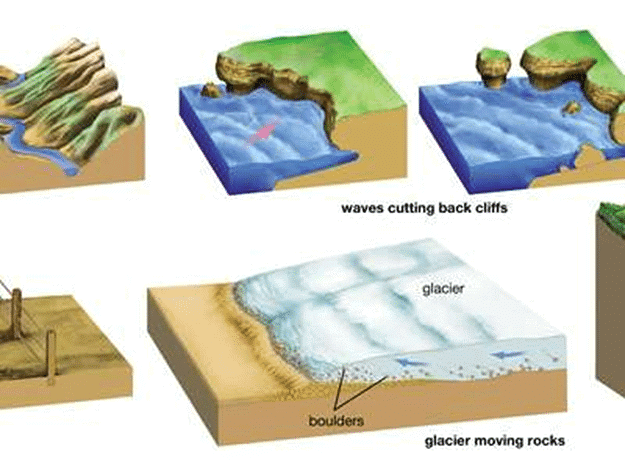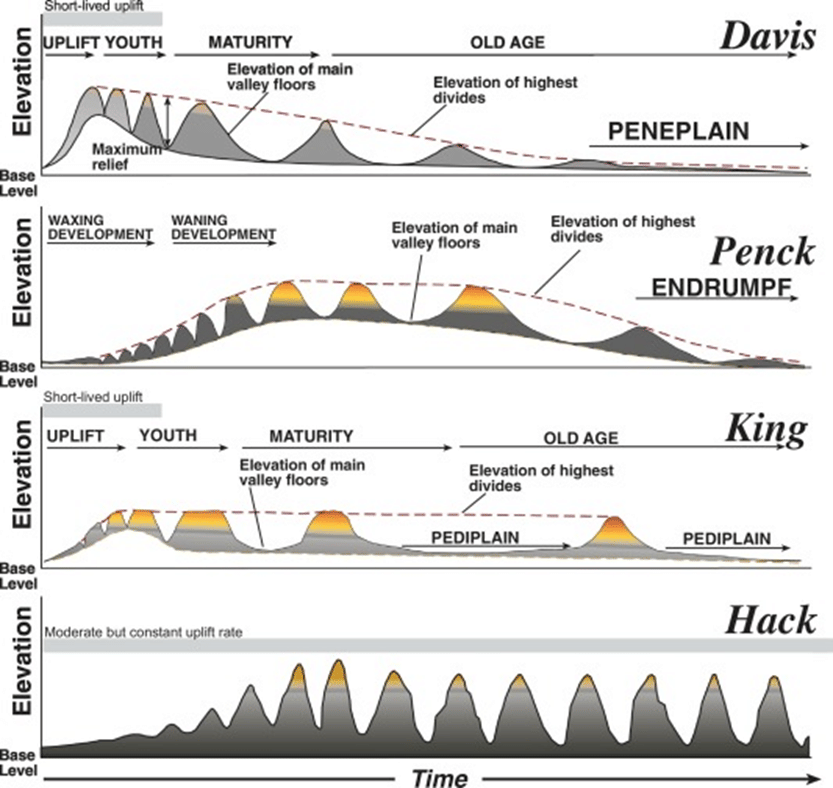Denudation Chronology | Geography Optional for UPSC PDF Download
Denudation chronology is the study of the historical development of landscapes through the processes of denudation, which involve the wearing away of Earth's surface by elements such as water, ice, wind, and waves. This approach aims to reconstruct the denudational history of a region by analyzing present-day landscapes, sediments, and relic landforms. It is based on concepts such as sequential landform change, uniformitarianism, cyclic nature of Earth's history, palimpsest topography, and Davisian model of cyclic evolution of landforms.

- The primary goal of denudation chronology is to identify, date, and interpret planation surfaces developed in past cycles and sub-cycles of erosion based on evidence from drainage development, river capture, relic surfaces, and past tectonic events. This approach emphasizes the historical development of landscapes and is based on the concept of palimpsest topography, which refers to surfaces that bear imprints of geomorphological processes from past geological periods.
- However, denudation chronology has some limitations, including the difficulty in explaining only small parts of existing landscapes due to the partial destruction of former surfaces by subsequent erosion. Additionally, this approach is highly speculative and deductive, as it relies on the researcher's ability to deduce the original forms and initial heights of old erosion surfaces and remnant forms that have been greatly modified by subsequent processes. Moreover, dating erosion surfaces can be challenging due to the lack of valid geological evidence.
- In summary, denudation chronology is an approach that attempts to reconstruct the historical development of landscapes through the study of denudation processes. Despite its limitations, this approach provides valuable insights into the complex topographic features and geological history of a region, helping us better understand the Earth's surface and the processes that have shaped it over time.

Conclusion
Denudation chronology is an approach in the study of landforms that focuses on reconstructing the historical development of landscapes through the analysis of erosion surfaces, drainage patterns, and geologic structures. This approach is based on the concept of palimpsest topography, which represents complex surfaces that have been shaped, erased, and reshaped by geomorphological processes over time. Despite its usefulness in understanding landscape evolution, denudation chronology has its limitations, such as difficulties in accurately identifying and dating remnant landforms and the speculative nature of the approach due to the lack of valid geological evidence.Frequently Asked Questions (FAQs) of Denudation Chronology
What is denudation and how does it affect Earth's surface?
Denudation is the process of wearing away the Earth's surface through the action of moving water, ice, wind, and waves. It leads to a reduction in elevation and relief of landforms and landscapes.
What is denudation chronology and why is it important in the study of landforms?
Denudation chronology is the reconstruction of the denudational history of a given region. It involves studying the traces left in present-day landscapes and sediments to understand the long-term landscape changes. This approach helps researchers to better understand the geological and geomorphological processes that have shaped a particular region over time.
What is the concept of palimpsest topography in denudation chronology?
Palimpsest topography refers to a landscape that has been shaped, reshaped, and modified by geomorphological processes over time, similar to a manuscript that has been written, erased, and rewritten multiple times. This concept is essential in denudation chronology, as it helps researchers to recognize and interpret the complex topographic features that have evolved through different stages of geological time.
What are some limitations of the denudation chronology approach?
Some limitations of the denudation chronology approach include the difficulty in explaining only small parts of the existing landscape, the highly speculative nature of the approach due to the modification of old erosion surfaces, and the challenges in dating erosion surfaces due to the lack of valid geological evidence.
How does the denudation chronology approach contribute to our understanding of Earth's history?
The denudation chronology approach allows researchers to reconstruct the geomorphic history of a region based on present and remnant landforms. This helps in understanding the various geological and geomorphological processes that have occurred over time, providing insights into the Earth's history and the development of its landscapes.
|
303 videos|636 docs|252 tests
|
FAQs on Denudation Chronology - Geography Optional for UPSC
| 1. What is denudation chronology? |  |
| 2. How is denudation chronology determined? |  |
| 3. What factors influence denudation chronology? |  |
| 4. Why is denudation chronology important in understanding landscape evolution? |  |
| 5. How does denudation chronology relate to the UPSC exam? |  |
















